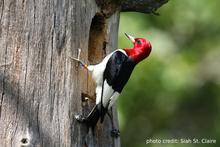Postdoctoral Researcher: Elena West
Principal Investigator: David E. Andersen
Funding: Minnesota Environmental Trust Fund as recommended by the Legislature-Citizen’s Commission on Minnesota Resources; Audubon Chapter of Minneapolis/Red-headed Woodpecker Recovery Project, University of Toledo
Collaborators: Cedar Creek Ecosystem Science Reserve, Audubon Chapter of Minneapolis/Red-headed Woodpecker Recovery Project, University of Toledo

Since 2017, Dr. Elena West and collaborators have been researching red-headed woodpecker demography, habitat associations, and migration ecology at sites in Minnesota, Ohio, and Michigan to elucidate critical periods, locations, life stages, and habitat characteristics associated with population growth rates and to provide habitat restoration and management recommendations for land managers and the public. Dr. West has led research in Minnesota at the Cedar Creek Ecosystem Science Reserve, which has the largest breeding population of this species in the entire state (about 80-100 pairs breed there each year). To examine migratory patterns and behaviors, Dr. West and her team marked 51 adult woodpeckers with 1.5-g backpack-mounted archival GPS tags (n = 29 females, n = 22 males). The team also used radio-telemetry to track the breeding season (May – September) movements and habitat use of adult red-headed woodpeckers. They marked woodpeckers with 2.5-g backpack-mounted radio-transmitters (n = 7 females, n = 23 males) and tracked individual birds by conducting ground-based telemetry surveys. To examine red-headed woodpecker nest success and nest site selection, Dr. West and her team monitored 135 nest attempts (n = 90 individual nest trees). To examine post-fledging survival, they tracked fledgling red-headed woodpeckers from a subset of these nests and will build spatially explicit models of full-season productivity (young raised to independence per breeding pair) and will eventually apply these models to the broader landscape using data from Cedar Creek and study sites in Ohio and Michigan.
In collaboration with the Cedar Creek Ecosystem Science Reserve and the Audubon Chapter of Minneapolis, Dr. West established a project using trail cameras mounted outside of nest cavities to capture the behaviors and interactions of red-headed woodpeckers and the community of animals that depend on and compete for these cavities. To date, the project has collected thousands of 10–30 second videos and the team has since launched the project on the online platform, Zooniverse, where citizen science volunteers can watch videos and help classify the behaviors and interactions of the animals in them, which can be used to further understand red-headed woodpecker ecology and behavior and the role that other animals play in nest predation and competition. One of the exciting aspects of this project has been the opportunity to engage with volunteers from around the world and share more about elements of animal life and ecosystems that many wouldn’t otherwise see. It has also been a unique way to share more about this research on red-headed woodpeckers, conservation, and habitat restoration. The project can be accessed at: https://z.umn.edu/woodpeckercams.
Dr. West and collaborators have presented their research at professional conferences (the Annual meeting of the Minnesota Ornithologist’s Union, the American Ornithological Society Annual Conference, and at the Toledo Museum of Natural History Forum on Local Natural History and Research), invited talks to public audiences through the University of Minnesota, Cedar Creek Ecosystem Science Reserve, multiple local Audubon Chapter organizations, and a naturalist club in Brandon Manitoba, Canada. Our research project was featured in articles in Terrain.org, the University of Minnesota College of Biological Sciences newsletter, and the Star Tribune.